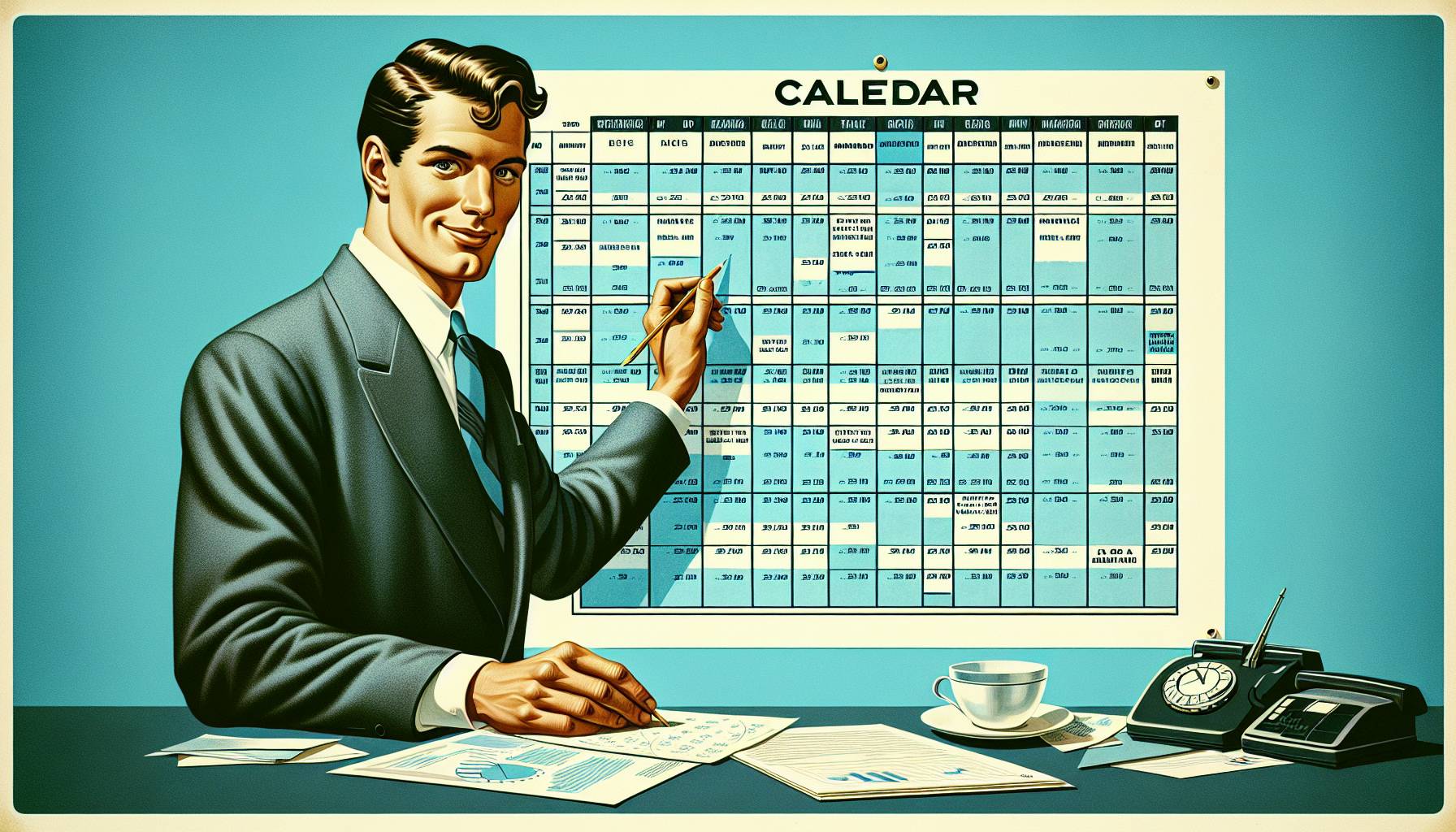

Imagine juggling chainsaws while riding a unicycle on a high-wire – welcome to the world of executive time management! Mastering the delicate balance of tasks and meetings is an essential and often daunting challenge that executives face daily.
In this article, we’ll dive into key strategies to perfect the art of scheduling meetings on your boss’s calendar, prioritize tasks and meetings for maximum productivity, wield effective scheduling techniques, identify and minimize time-wasting activities, and harness the power of tech tools and apps to optimize meeting scheduling.
By blending flexibility and adaptability, you’ll transform your boss’s calendar into a synchronized masterpiece of efficiency. Say goodbye to chaos as you embrace the path to executive time mastery!
Understanding the Importance of Time Management in the Executive Role
Time management is indispensable in the executive role, fostering enhanced productivity and proficient decision-making. Executives are often faced with a multitude of tasks, ranging from managing teams and resources to making crucial decisions that could impact the company. By perfecting the scheduling of meetings, prioritizing tasks, and delegating responsibilities, executives can devote more time to more significant matters. For instance, a study from McKinsey exemplified that CEOs who effectively managed their time saw an increase of up to 25% in their overall productivity. Consequently, mastering effective time management becomes crucial in ensuring the smooth functioning of an organization.
Transitioning towards efficient time management begins by thoroughly analyzing your current methodologies and identifying disruptions in your workflow. Once the bottlenecks are discerned, executives can employ various tools and strategies to streamline their schedules.
For example, using time-blocking techniques or employing digital assistants to organize meetings can substantially reduce time spent on repetitive tasks. Regularly reviewing and setting goals helps maintain focus on long-term objectives.
Ultimately, refining your time management skills as an executive will lead to increased productivity, more effective decision-making, and a heightened ability to achieve your company’s strategic goals.
Prioritizing Tasks and Meetings for Maximum Productivity
Prioritizing tasks and meetings for maximum productivity is crucial to master executive time efficiently. A successful executive calendar should avoid clutter by focusing on the most vital tasks and meetings, ensuring the boss has ample time to deal with essential responsibilities. To achieve this, start by categorizing tasks according to their importance and urgency, tackling tasks that contribute directly to the company’s goals first. For example, prioritize meeting with a potential investor over a less time-sensitive discussion that could be postponed or delegated. Furthermore, incorporating time management strategies such as the Eisenhower Matrix or the Kanban methodology can help executives stay focused on high-priority tasks and optimize their schedules.
Cohesive scheduling of tasks and meetings not only contributes to smooth operations but also provides space for creative thinking and strategic planning.
To ensure maximum productivity throughout the workday, use natural energy peaks to schedule demanding tasks, meetings, and brainstorming sessions. According to circadian rhythms, our ability to focus is generally at its peak during the late morning, providing an optimal window to engage in critical tasks or high-stakes meetings.
Additionally, consider incorporating brief, regular breaks into the schedule, which can help maintain focus and prevent brain fatigue. Leveraging tools such as calendar blocking and the Pomodoro Technique can be beneficial in structuring breaks and refining focus throughout the day. By prioritizing tasks effectively, you’ll be well-equipped to make the most out of your boss’s calendar and ensure maximum productivity.
Effective Scheduling Techniques for Executive Calendars
To maximize an executive’s productivity, effective scheduling techniques for their calendars are crucial. By implementing strategies like time blocking, anticipating potential scheduling conflicts, and making use of digital tools, assistants can efficiently organize their boss’s calendar, resulting in increased work efficiency, minimal disruptions, and a more focused work environment. Time blocking, for instance, entails setting aside chunks of time for specific tasks or meetings, ensuring sufficient preparation and focused effort.
Additionally, by predicting clashes in the schedule, assistants can proactively reschedule or adjust events to avoid unnecessary stress, ensuring a well-functioning workspace.
Technology can significantly streamline the scheduling process, with numerous digital tools available for executive assistants. For example, software like Calendly, Doodle, or Microsoft Outlook’s scheduling assistant simplifies finding mutually suitable meeting times by sharing available slots with participants and automatically updating calendars. Furthermore, virtual assistants, like Google Assistant, Siri, or Amazon Alexa, can be incredibly helpful in managing calendars using simple voice commands, increasing efficiency and accessibility. Refining one’s scheduling techniques is essential for any executive assistant, ultimately contributing to a more productive and successful work environment.
[Related: Conquering the Chaos: How to Conduct an Effective Calendar Audit]
Identifying and Minimizing Time-Wasting Activities
One significant key to executive time mastery lies in identifying and minimizing time-wasting activities in your boss’s schedule. To accomplish this, it is crucial to conduct an audit of your boss’s daily tasks and meetings, analyzing the value and relevance of each item. This process will allow you to zero in on activities that either do not contribute to productivity or consume too much time. For instance, you may discover that your boss spends excessive time on non-essential emails, or that certain meetings lack a clear purpose and outcome.
By eliminating these distractions, you can free up valuable time that can be invested in more important matters such as pursuing business goals and opportunities.
The next step in achieving executive time mastery is to devise strategies that minimize the occurrence of time-wasting activities in the future. One effective method is to encourage the use of agendas for meetings to ensure that they maintain structure and purpose. Additionally, allot specific blocks of time for going through emails and assign priority levels to help manage those incoming communications more efficiently. Consider also advocating for the implementation of time management tools and techniques like the Pomodoro Technique to maintain focus and prevent distractions. By consistently applying these strategies, you will successfully guide your boss towards a more efficient and well-organized schedule, effectively promoting executive time mastery.
Utilizing Tech Tools and Apps to Optimize Meeting Scheduling
Harnessing the power of technology, numerous apps and tools can streamline the process of scheduling meetings, ensuring an efficient use of time and resources for executives and their assistants. For example, tools like Calendar (https://www.calendar.com/) and Doodle (https://doodle.com/) employ AI algorithms to analyze schedules, auto-detect time zones, and conveniently suggest suitable scheduling events for all attendees. Additionally, some phone assistants such as Siri and Google Assistant can even set up meetings on the go, providing suggestions for nearby meeting locations and offering automatic transportation options.
To successfully implement technology within a company’s scheduling framework, it is essential to set up shared calendar systems that are easily accessible to all relevant parties. Google Calendar and Microsoft Outlook are popular choices that showcase an individual’s availability and allow for easy meeting invitations. Commendable meeting management tools, such as Timebridge (https://www.timebridge.com/) and Clara (https://www.claralabs.com/), can further integrate with these shared calendars, giving assistants the ability to schedule meetings, reserve rooms, and send reminder notifications effortlessly. Such seamless integration of technology optimizes meeting scheduling, ensuring that time is effectively managed for both the executive and their support staff.
[Related: Achieving Task Mastery With Strategic Calendar Use]
Strategies for Maintaining Flexibility and Adaptability
In today’s fast-paced business world, maintaining flexibility and adaptability when scheduling meetings is crucial for a boss’s productivity and success. One effective strategy is to implement buffer time between appointments, allowing for unexpected issues to arise without derailing the entire day. For instance, if a critical meeting wraps up early or runs overtime, a 15 to 30-minute buffer can provide ample time for the boss to adequately prepare for the next engagement. Additionally, consider setting aside specific times for impromptu meetings, ensuring that important last-minute discussions can still take place without causing disruptions.
Implementing a scheduling tool can greatly assist in this process, providing both visibility and control over the boss’s calendar. Leverage technology, such as scheduling software and mobile applications, to allow for real-time adjustments and reminders, which enables the boss to review and address any changes more efficiently. For example, an application like Calendly or Doodle permits attendees to suggest and confirm meeting times within a specified range, permitting efficiency and preventing overbooking. Furthermore, strengthening communication lines among team members will foster collaboration, thus ensuring everyone remains informed and can adapt quickly to any schedule changes. In summary, striking a balance between structure and flexibility is essential for maintaining efficient and productive calendar management.
Closing Thoughts
In conclusion, mastering the art of executive time management is an invaluable skill that plays a critical role in catapulting one’s career to greater heights. By fully grasping the significance of time management in the executive role, prioritizing tasks and meetings for maximum productivity, and applying effective scheduling techniques, one can successfully navigate the intricacies of an executive calendar. Additionally, identifying and reducing time-wasting activities, leveraging technological advancements in scheduling tools, and retaining flexibility and adaptability all contribute to creating a perfectly scheduled work environment. By incorporating these time mastery strategies into your daily routine, you will not only optimize your meeting scheduling but also maximize your potential for personal and professional growth.
Frequently Asked Questions
Why is time management important for executives?
Time management is crucial for executives as it enhances productivity and decision-making, allows for the efficient allocation of resources, and helps focus on tasks that directly contribute to the company’s goals. Effective time management leads to increased productivity, better decision-making, and a heightened ability to achieve strategic objectives.
How can I prioritize tasks and meetings for maximum productivity?
Prioritizing tasks can be achieved by categorizing them according to their importance and urgency, focusing on those that contribute directly to the company’s goals. Time management strategies, such as the Eisenhower Matrix or the Kanban methodology, can help optimize schedules.
Moreover, understanding energy peaks related to circadian rhythms and using techniques like calendar blocking and the Pomodoro Technique can help structure breaks and maintain focus throughout the day.
What are some effective scheduling techniques for executive calendars?
Effective scheduling techniques include time blocking, anticipating potential scheduling conflicts, and utilizing digital tools. Time blocking allows the allocation of specific time chunks for tasks or meetings, while predicting scheduling conflicts helps avoid disruptions. Technology, such as Calendly, Doodle, or Outlook’s scheduling assistant, as well as virtual assistants like Google Assistant, Siri, or Amazon Alexa, can further streamline the scheduling process.
How can I identify and minimize time-wasting activities?
Perform an audit of the executive’s daily tasks and meetings to analyze the value and relevance of each item. Identify activities that do not contribute to productivity or consume too much time and eliminate these distractions.
Implement strategies that minimize the recurrence of such activities, such as using agendas for meetings, assigning priority levels for emails, and adopting time management tools like the Pomodoro Technique.
What tech tools and apps can be used to optimize meeting scheduling?
Apps like Calendar, Doodle, Siri, and Google Assistant can help with scheduling meeting times, detecting time zones, and managing calendars. Shared calendar systems, such as Google Calendar and Microsoft Outlook, provide visibility and accessibility to all relevant parties.
Meeting management tools like Timebridge and Clara can integrate with these shared calendars and assist with scheduling meetings, reserving rooms, and sending reminders more efficiently.
How can I maintain flexibility and adaptability in scheduling meetings?
Implement buffer time between appointments to accommodate unexpected changes and provide time for adequate preparation.
Set aside specific times for impromptu meetings, and use scheduling tools that allow for real-time adjustments and reminders. Strengthen communication among team members to foster collaboration and quick adaptation to schedule changes.
Find a balance between structure and flexibility to ensure efficient and productive calendar management.











Howie Jones
My name is Howie and I'm a Customer Success Manager at Calendar. I like to ensure our customers get the best experience using our product. If you have questions email me howie at calendar.com